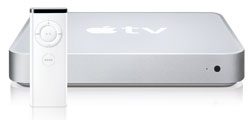Theories on Apple TV


While Apple TV is more or less an Airport Express for video (streaming iTunes video content to a TV like the Airport Express streams music to speakers) it has the potential to be so much more.
Apple TV has the potential to be a trojan horse into the living room and PBS' Bob Cringely, in his The Pulpit column, theorizes that because Apple TV is an always-on device with a 40GB hard drive, Apple may move to content distribution via a P2P network. From Slashdot:
The ISPs will incur higher bandwidth locally, possibly lose some subscribers to cable TV, but have fewer costs through the Tier II Internet backbone providers. Bob also expects that Google will be involved with their fiber network and advertising expertise, and my hope is that they'll bundle in YouTube content as well... Eventually, he hopes, we'll see a real HD revolution from Apple and Google for this service."
After reading through the Apple TV product pages in more detail I am concerned by three things:
1. Apple TV can only stream content that's in your iTunes library and Photos from iPhoto - at least initially. Which means that other content (including DVDs, DiVX, .AVI, .WMV, etc.) will not be able to be streamed to Apple TV - unless you convert them to something that plays in iTunes first. This will be a deal-breaker for many people. Hopefully a third-party developer is developing a workaround (like Rogue Amoeba's excellent AirFoil). And what about us Aperture users, Apple?
2. Apple TV only connects to TVs that have either HDMI (digital) or component video (analog) inputs. Component video inputs are (R)ed (G)reen and (B)lue and are not to be confused with the yellow RCA cable, which is composite video (also known as "S-video"). RGB was never popular in North America for consumer electronics, as S-video was considered good enough. This effective limits the Apple TV to consumers that own a relatively modern TV set.
3. Apple TV requires a widescreen set. While many people are upgrading to widescreen sets, I wonder what percentage of the TV-owning public currently owns either an Enhanced Definition (ED) or High Definition (HD) set? According to Apple's system requirements you need:
Enhanced-definition or high-definition widescreen TVs capable of 1080i 60/50Hz, 720p 60/50Hz, 576p 50Hz (PAL format), or 480p 60Hz
Check the your TV carefully before you run out to buy an Apple TV!
[poll id=38]